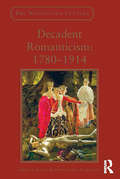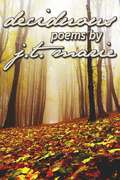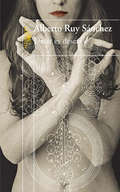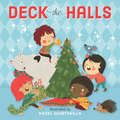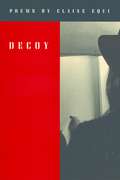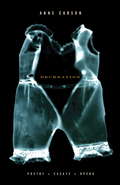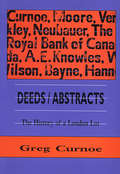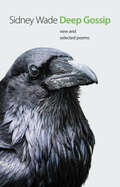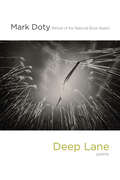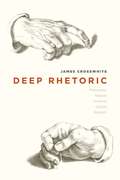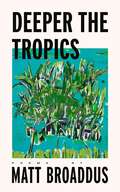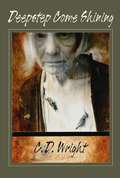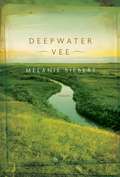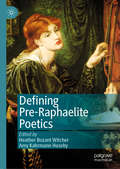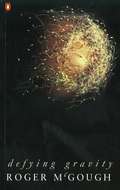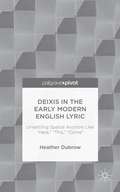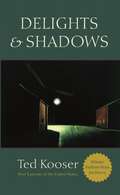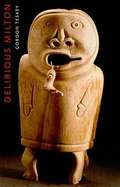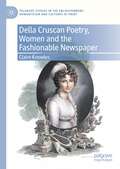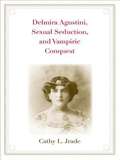- Table View
- List View
Decadent Romanticism: 1780-1914
by Kostas Boyiopoulos Mark SandyFor Decadent authors, Romanticism was a source of powerful imaginative revisionism, perversion, transition, and partial negation. But for all these strong Decadent reactions against the period, the cultural phenomenon of Decadence shared with Romanticism a mutual distrust of the philosophy of utilitarianism and the aesthetics of neo-Classicism. Reflecting on the interstices between Romantic and Decadent literature, Decadent Romanticism reassesses the diverse and creative reactions of Decadent authors to Romanticism between 1780 and 1914, while also remaining alert to the prescience of the Romantic imagination to envisage its own distorted, darker, perverted, other self. Creative pairings include William Blake and his Decadent critics, the recurring figure of the sphinx in the work of Thomas De Quincey and Decadent writers, and Percy Shelley with both Mathilde Blind and Swinburne. Not surprisingly, John Keats’s works are a particular focus, in essays that explore Keats’s literary and visual legacies and his resonance for writers who considered him an icon of art for art’s sake. Crucial to this critical reassessment are the shared obsessions of Romanticism and Decadence with subjectivity, isolation, addiction, fragmentation, representation, romance, and voyeurism, as well as a poetics of desire and anxieties over the purpose of aestheticism.
Deciduous
by J. T. MarieShort chapbook of 36 poems which capture the ephemeral quality of nature. In these pages, autumn's dying leaves crumple beneath winter's shroud of snow, and the last fleeting days of the year slip away forever.Tragic, melancholy, bittersweet ... these poems embrace and revel in the changing seasons, which mirror so closely the rhythm of the human heart.
Decir es desear
by Alberto Ruy SánchezColección de poemas de Alberto Ruy Sánchez. Por Alberto Ruy Sánchez, autor de La mano del fuego y reconocido como Oficial de la Orden de las Artes y de las Letras por el gobierno de Francia. Para celebrar la primera edición, en un mismo formato y colección, del conjunto de novelas que forman lo que ahora se conoce como El quinteto de Mogador: Los nombres del aire, En los labios del agua, Los jardines secretos de Mogador: voces de tierra, La mano del fuego y Nueve veces el asombro, y que no han dejado de ser reeditadas desde la aparición de la primera en 1987, Alfaguara ha querido compartir con sus lectores esta colección de poemas del autor.
Deck the Halls
by Running Press'Tis the season to be jolly with this new, festive board book featuring a timeless, favorite Christmas carol.Deck the halls with boughs of holly and share the joy of Christmas with your entire family in this beautiful rendition of a classic Christmas carol. Possibly part of a new series of board books for young ones to sing along with each holiday season, this book will be full of bursts of color and sweet, furry creatures that help herald in the holiday season.
Decolonial Animal Ethics in Linda Hogan’s Poetry and Prose: Towards Interspecies Thriving (Routledge Studies in World Literatures and the Environment)
by Małgorzata PoksInterspecies cosmopolitanism—understood as an effort to build a pluriversal world in which multiple forms of life can coexist—is all the more urgent in a world of already entangled biosystems, multispecies contact zones, and human/more-than-human interfaces. Critiquing the liberal discourse on animal rights for perpetuating colonial hierarchies, this volume argues that imagining a human-animal cosmopolis should be done in dialogue with traditional tribal cultures, which envision animal persons as agential beings, teachers, and relatives of the humans they have coevolved with. Steeped in North America’s Indigenous worldviews, it focuses on such questions as: who are the animals we share our earthly lives with, what can they teach us about ourselves, how can animals guide us toward more sustainable futures, and what are the conditions of possibility of human-animal thriving? This is also the first book-length study of Linda Hogan’s prose and poetry written from decolonial animal studies perspective.
Decoy
by Elaine EquiPoems by Elaine Equi "In Elaine Equi's brilliant Decoy, each poem is a 'neatly folded labyrinth.' Here everything is artifice--like the labyrinth, a deadly little joke, one we're 'in on' until, suddenly, we're not so sure. The poems in this book are both spooky and spoofy. Eventually we realize that, despite its campy, B-movie trappings, the monster (our world) is real. We realize this gradually because of Equi's light touch. Like Muhammed Ali, she floats while stinging." --Rae Armantrout "Decoy moves upon you gradually with postludes of gentleness . . . then agile maneuvers that seize us unaware. The flawless title poem, 'Decoy,' twists as if on a perilous frame, and it is. We acknowledge the dependency of poetry on the poet's sensibility. Here at each turn of her stanzas, askew or bluntly set . . . the poem feasts on dependency. 'o empiricism / o anatomy.' O poet." --Barbara Guest
Decreation: Poetry, Essays, Opera
by Anne CarsonIn her first collection in five years, Anne Carson contemplates “decreation”–an activity described by Simone Weil as “undoing the creature in us”–an undoing of self. But how can we undo self without movingthroughself, to the very inside of its definition? Where else can we start? Anne Carson’sDecreationstarts with form–the undoing of form. Form is various here: opera libretto, screenplay, poem, oratorio, essay, shot list, rapture. The undoing is tender, but tenderness can change everything, or so the author appears to believe. From the Hardcover edition.
Deeds / Abstracts: The History of a London Lot
by Greg CurnoeBefore his tragic death in 1992, Greg Curnoe had submitted to Brick Books a manuscript based on extraordinarily detailed research into the history of 38 Weston, his address in London, Ontario. The result is a journal/collage that traces the occupancy of that one small plot of land hundreds of years back into aboriginal times when land in this country was not plotted according to the laws of geometry. Deeds/Abstracts is an intensely concentrated and particular cross-section of Canadian history, layer upon layer upon layer. Brick Books is proud to offer this exemplary work-in-progress (a 500-year diary can never be complete) assembled by a much-loved and keenly-lamented Canadian artist of the first importance. Front and back covers are after paintings by Greg Curnoe. The text includes 12 colour plates of photographs and Curnoe paintings.
Deep Gossip: New and Selected Poems (Johns Hopkins: Poetry and Fiction)
by Sidney WadeA great and frequently subversive book by a lyric poet at the height of her craft.Throughout her seven critically acclaimed collections, Sidney Wade has established herself as a poet with a serious but light touch, capable of the clarity and inventiveness it takes to work a problem to both pleasure and resolution. Playing with and challenging form in all directions, the 27 new and 96 selected poems in Deep Gossip bristle with a sly wit that trips and delights the reader. Inspired by landscape, language, music, and living things, as well as the occasional bout of political outrage, Deep Gossip is a smart collection.Praise for Other Books by Sidney Wade"The quick, closely observed poems in Sidney Wade's beguiling Bird Book move from page to page like their subjects—in flight, on air, a murmuration sweeping across the horizon."—William Souder"Sidney Wade's linguistic and philosophical turns in Bird Book confirm that she is both the supreme heir to Wallace Stevens and one of the most original poets in the language."—Randall Mann"This is a beautiful, wise, and timely collection."—Daniel Anderson"As impressive and thrillingly exact as these poems are concerning matters ornithological, it is the exquisite music —'earth-sprung, bright, and resonant'—of Wade's radically short line that so enchants me, the free play of interlinear rhyme, phonemic harmonies, and small bursts of metrical rhythms that yield more vitality and delight than any gathering of poems I have encountered in a very long time."—B. H. Fairchild"Her poems [are]... a particular and splendid instance of what Hopkins meant by 'poetry proper, the language of inspiration.' "—Richard Howard
Deep Lane: Poems
by Mark Doty"Elegant, plain-spoken, and unflinching, Mark Doty's poems . . . invite us to share their ferocious compassion."--National Book Award, judges' citation for Fire to Fire Mark Doty's poetry has long been celebrated for its risk and candor, an ability to find transcendent beauty even in the mundane and grievous, an unflinching eye that--as Philip Levine says--"looks away from nothing." In the poems of Deep Lane the stakes are higher: there is more to lose than ever before, and there is more for us to gain. "Pure appetite," he writes ironically early in the collection, "I wouldn't know anything about that." And the following poem answers: Down there the little star-nosed engine of desire at work all night, secretive: in the morning a new line running across the wet grass, near the surface, like a vein. Don't you wish the road of excess led to the palace of wisdom, wouldn't that be nice? Deep Lane is a book of descents: into the earth beneath the garden, into the dark substrata of a life. But these poems seek repair, finally, through the possibilities that sustain the speaker aboveground: gardens and animals, the pleasure of seeing, the world tuned by the word. Time and again, an image of immolation and sacrifice is undercut by the fierce fortitude of nature: nature that is not just a solace but a potent antidote and cure. Ranging from agony to rapture, from great depths to hard-won heights, these are poems of grace and nobility.
Deep Rhetoric: Philosophy, Reason, Violence, Justice, Wisdom
by James Crosswhite“Rhetoric is the counterpart of logic,” claimed Aristotle. “Rhetoric is the first part of logic rightly understood,” Martin Heidegger concurred. “Rhetoric is the universal form of human communication,” opined Hans-Georg Gadamer. But in Deep Rhetoric, James Crosswhite offers a groundbreaking new conception of rhetoric, one that builds a definitive case for an understanding of the discipline as a philosophical enterprise beyond basic argumentation and is fully conversant with the advances of the New Rhetoric of Chaïm Perelman and Lucie Olbrechts-Tyteca. Chapter by chapter, Deep Rhetoric develops an understanding of rhetoric not only in its philosophical dimension but also as a means of guiding and conducting conflicts, achieving justice, and understanding the human condition. Along the way, Crosswhite restores the traditional dignity and importance of the discipline and illuminates the twentieth-century resurgence of rhetoric among philosophers, as well as the role that rhetoric can play in future discussions of ontology, epistemology, and ethics. At a time when the fields of philosophy and rhetoric have diverged, Crosswhite returns them to their common moorings and shows us an invigorating new way forward.
Deep Water
by Jamie Sumner&“Readers will feel every wave of Tully&’s emotions as she risks everything to try to get her mom&’s attention. A powerful novel in verse.&” —Lisa Fipps, author of Printz Honor book Starfish A middle grade novel in verse that &“packs a powerful punch&” (Kirkus Reviews) from acclaimed author Jamie Sumner that spans one girl&’s marathon swim over twelve miles and six hours, calling her mom back home with every stroke.Six hours. One marathon swim. That&’s all Tully Birch needs to get her life straightened out. With the help of her best friend, Arch, Tully braves the waters of Lake Tahoe to break the record for the youngest person ever to complete the famous &“Godfather swim.&” She wants to achieve something no one in the world has done, because if she does, maybe, just maybe, her mom will come back. The swim starts off well—heart steady, body loose, Arch in charge of snacks as needed. But for Tully, all that time alone with her thoughts allows memories to surface. And in the silence of deep waters, sadness can sink you. When the swim turns dangerous, Tully fights for her survival. Does she keep going and risk her own safety and Arch&’s? Or does she quit to save them both, even if it means giving up hope that her mother will return?
Deeper the Tropics
by Matt BroaddusDeeper the Tropics navigates the mythology of the self via the masked figure. These poems present the self as an accumulation of faces—or masks—over which we have only partial control. Yet it’s in this semi-public, semi-private space of self where the poems celebrate the imaginative leaps we take to find ourselves in ever-changing configurations. Operating between local and global, fantasy and history, this collection explores the self in a liminal space where simultaneities propagate.
Deepstep Come Shining
by C. D. WrightRebellious and fiercely lyrical, the poems of C.D. Wright incorporate elements of disjunction and odd juxtaposition in their exploration of unfolding context. "In my book," she writes, "poetry is a necessity of life. It is a function of poetry to locate those zones inside us that would be free, and declare them so."C.D. Wright was born and raised in the Ozark Mountains of Arkansas. She has received numerous awards for her work, including grants from the National Endowment for the Arts, the Guggenheim Foundation, the American Academy and Institute for Arts and Letters, and the Lila Wallace-Reader's Digest Foundation. She teaches at Brown University in Rhode Island."Expertly elliptical phrasings, and an uncounterfeitable, generous feel for real people, bodies and places, have lately made Wright one of America's oddest, best and most appealing poets. Her tenth book consists of a single long poem whose sentences, segments and prose-blocks weave loosely around and about, and grow out of, a road trip through the rural South. Clipped twangs, lyrical 'goblets of magnolialight,' and recurrent, mysterious, semi-allegorical figures like 'the snakeman' and 'the boneman' share space with place names, lexicographies, exhortations and wacky graffiti ('God is Louise').... cherish Wright's latest 'once-and-for-all thing, opaque and revelatory, ceaselessly burning.'"--Publishers Weekly"For me, C.D. Wright's poetry is river gold. 'Love whatever flows.' Her language is on the page half pulled out of earth and rivers--still holding onto the truth of the elements. I love her voice and pitch and the long snaky arms of her language that is willing to hold everything--human and angry and beautiful."--Michael Ondaatje"C.D. Wright is entirely her own poet, a true original."--The Gettysburg Review
Deepwater Vee
by Melanie SiebertMelanie Siebert's stunning debut collection travels remote northern rivers, as well as two of Canada's most threatened rivers, the Athabasca and the North Saskatchewan. These rivers push the poems into a contemplation of loss and into the terrain of Alexander Mackenzie's dreams, a busker's broken-down street riffs, and the borderland wanderings of a grandmother whose absence is felt as a presence. The poems' currents are turbulent, braided, submerged. Narrative streams appear like tributaries glimpsed through brush, and then veer into unexpected territories, where boundaries blur - between the self and the other, between the living and the dead, between the human and the wild - and loss carries with it both music and silence. In this virtuoso collection, Melanie Siebert has transformed language into that rarest thing, a singular poetic vision.From the Trade Paperback edition.
Defining Pre-Raphaelite Poetics
by Heather Bozant Witcher Amy Kahrmann HusebyDefining Pre-Raphaelite Poetics offers a range of Pre-Raphaelite literary scholarship, provoking innovative discussions into the poetic form, gender dynamics, political engagement, and networked communities of Pre-Raphaelitism. The authors in this collection position Pre-Raphaelite poetics broadly in the sense of poiesis, or acts of making, aiming to identify and explore the Pre-Raphaelites’ diverse forms of making: social, aesthetic, gendered, and sacred. Each chapter examines how Pre-Raphaelitism takes up and explores modes of making and re-making identity, relationality, moral transformations, and even, time and space. Essays explore themes of formalist or prosodic approaches, expanded networks of literary and artistic influence within Pre-Raphaelitism, and critical legacies and responses to Pre-Raphaelite poetry and arts, codifying the methods, forms, and commonalties that constitute literary Pre-Raphaelitism.
Defying Gravity
by Roger McGoughIn this evocative and personal collection of poems Roger McGough comes to terms with painful memories as well as confronting fears that are universal. Here he remembers his father in ‘Squaring Up’ and ‘Alphabet Soup’; observes the eccentricities of contemporary life in ‘The City of London Tour’; gives insights into human feeling with the surreal ‘Your Favourite Hat’ and the moving elegy ‘Defying Gravity’; and muses on writing itself with ‘Word Trap’ and ‘The Darling Buds of Maybe’. There are even witty poems dedicated to the chemical elements. Blending the everyday and the magical, his verses sparkle with verbal dexterity, irreverent humour, irony and heartfelt compassion.
Deixis in the Early Modern English Lyric: Unsettling Spatial Anchors Like Here, This, Come
by Heather DubrowThis book engages with deictics ('pointing' words like here/there, this/that) of space. It focuses on texts by Donne, Shakespeare, Spenser, and Wroth in particular, relating their forms of deixis to cultural and generic developments; but it also suggests parallels with both iconic and neglected texts from a range of later historical periods.
Deliberate Prose: Selected Essays 1952-95
by Bill Morgan Allen GinsbergThought of Ginsberg on a wide range of topics, predominantly on literature and culture.
Delights and Shadows: Poems
by Ted KooserTed Kooser is a master of metaphor, a poet who deftly connects disparate elements of the world and communicates with absolute precision. Critics call him a “haiku-like imagist” and his poems have been compared to Chekov’s short stories. In Delights and Shadows, Kooser draws inspiration from the overlooked details of daily life. Quotidian objects like a pegboard, creamed corn and a forgotten salesman’s trophy help reveal the remarkable in what before was a merely ordinary world.<P><P> Ted Kooser is the author of eight collections of poems and a prose memoir. He lives on a small farm in rural Nebraska.<P> Pulitzer Prize Winner
Delilah's Daughters: A Novel
by Angela BensonAn inspirational story about the allure of fame and the faith that binds a family forever . . .Delilah Monroe has done everything in her power to keep her three daughters strong since the death of her husband. And a big part of that connection is their singing group, Delilah's Daughters. Veronica, Roxanne, and Alisha each have their own unique sense of self, but they all share the dream of Delilah's Daughters hitting the Billboard charts.Now, just as they enter the final round of a national talent show, a record producer approaches Veronica with the promise of fame . . . if she goes solo. Then the man Delilah has always leaned on wants more from her than just friendship, and someone from her past comes calling with a shocking secret. Will Delilah be able to hold her family together?
Delirious Milton: The Fate of the Poet in Modernity
by Gordon TeskeyComposed after the collapse of his political hopes, Milton's great poems Paradise Lost, Paradise Regained, and Samson Agonistes are an effort to understand what it means to be a poet on the threshold of a post-theological world. The argument of Delirious Milton, inspired in part by the architectural theorist Rem Koolhaas's Delirious New York, is that Milton's creative power is drawn from a rift at the center of his consciousness over the question of creation itself. This rift forces the poet to oscillate deliriously between two incompatible perspectives, at once affirming and denying the presence of spirit in what he creates. From one perspective the act of creation is centered in God and the purpose of art is to imitate and praise the Creator. From the other perspective the act of creation is centered in the human, in the built environment of the modern world. The oscillation itself, continually affirming and negating the presence of spirit, of a force beyond the human, is what Gordon Teskey means by delirium. He concludes that the modern artist, far from being characterized by what Benjamin (after Baudelaire) called "loss of the aura," is invested, as never before, with a shamanistic spiritual power that is mediated through art.
Delivering the News (Hugh MacLennan Poetry Series #47)
by Thomas O'GradyWar, Pestilence, Famine, Death. Was I deaf / to the headline roar of my unwieldy load? Engaging with the inevitability of change and flux, Thomas O'Grady's poems grapple with themes of death and rebirth, of loss and resiliency, of ebb and flow within nature and within individual lives and romantic and domestic relationships. Bookended by the springtime of “Controlled Burn” and its mirror, the wistfully autumnal “Magritte,” the collection follows multiple arcs within and across poems and longer sequences. Part I, "Seeing Red," grounds the poems in the rural landscapes, shorescapes, and streetscapes of the poet's childhood on Prince Edward Island, leading O'Grady home as he returns to “the heartening blaze / of red that frames the doors, // the eaves, the corner trim / of every outlying / Island barn and shed.” Part II, “The Wide World,” comprises poems prompted by more cosmopolitan landscapes, both literal and figurative, and inspired by the graphic arts, jazz music, classical mythology, and other writers. A later sequence of eight poems reflects O'Grady's Irish heritage within the social fabric of PEI. Through precise and steadying language, Delivering the News reflects the capacity of poetry both to acknowledge and to mitigate life's mutability.
Della Cruscan Poetry, Women and the Fashionable Newspaper (Palgrave Studies in the Enlightenment, Romanticism and Cultures of Print)
by Claire KnowlesThis book explores Della Cruscan poetry in the late eighteenth-century literary scene. A sociable, ornate, and deeply theatrical type of poetry, Della Cruscanism was associated with writers like Robert Merry, Mary Robinson, and Hannah Cowley. While Merry is the poet most commonly associated with the Della Cruscan school, this book argues that Della Cruscanism was a movement dominated by female poets and that this was one of the key reasons for the later disavowal and downgrading of its poetic accomplishments. It offers a close examination of these women writers and their role in shaping the poetic culture of the fashionable newspaper. In doing so, this study offers the first account of the feminization of the fashionable newspaper and of popular literary culture in the final years of the eighteenth century.
Delmira Agustini, Sexual Seduction, and Vampiric Conquest
by Cathy L. JradeDelmira Agustini (1886–1914) has been acclaimed as one of the foremost modernistas and the first major woman poet of twentieth-century Spanish America. Critics and the reading public alike were immediately taken by the originality and power of her verse, especially her daring eroticism, her inventive appropriation of vampirism, and her morbid embrace of death and pain No work until now, however, has shown how her poetry reflects a search for an alternative, feminized discourse, a discourse that engages in an imaginative dialogue with Rubén Darío’s recourse to literary paternity and undertakes an audacious rewriting of social, sexual, and poetic conventions. In the first major exploration of Agustini’s life and work, Cathy L. Jrade examines her energizing appropriation and reinvention of modernista verse and the dynamics of her breakthrough poetics, a poetics that became a model for later women writers.
